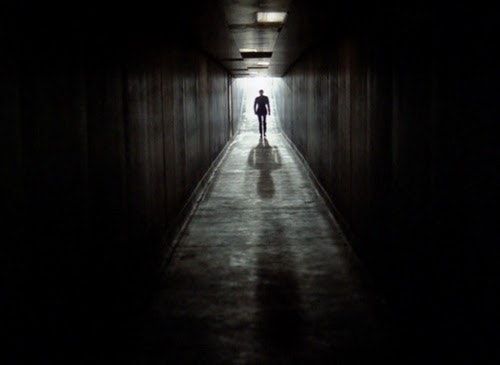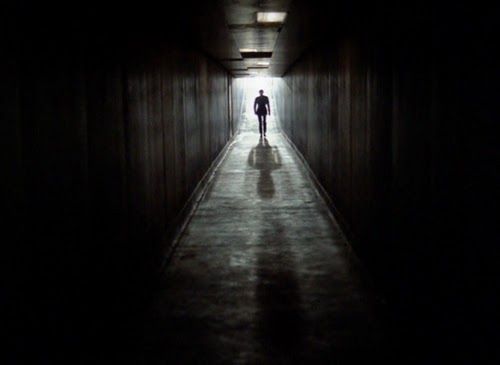The Prisoner and the Golden Gateway

"Where does it come from? How does it get here? The milk? The ice cream? The potatoes and the aspirins! At night, when everyone's asleep? I've never seen a night. I just sleep."
-Number 6, from The Prisoner episode 7, "Dance of the Dead"
I moved to San Francisco recently, against the current of a mass emigration that’s finally made the rent imaginable for someone like me. With a new place comes a new walk, and then a new obsession. Here, that obsession is a hidden valley elevated some twenty feet above the city: the complex known as the Golden Gateway, which merges to the south into Embarcadero Center.
The Golden Gateway doesn’t overlook the Golden Gate. Its views are of the Bay Bridge. It was built over the remains of the city’s old produce district, where Italian-American farmers trucked their crops into a big outdoor market for sale. You know that late-midcentury story: the city doesn’t like the people who live and work in a neighborhood; they declare it “blighted,” tear it down, and replace it with raw concrete teased into a shape. The Golden Gateway went up in the late 1960s, Embarcadero Center a few years later.
The two complexes are hidden from street level. You have to go up a few flights of stairs to see them, and most of the stairs are subtle, with the exception of a grand brick staircase in a nearby park. These stairs are not policed, or not in a way that I can see, but it’s easy to imagine them as a chokepoint that you can defend, which is probably the idea. Fantasies of “zombie apocalypse” are mostly just anxious visions of uprising by the downtrodden, which is a quiet part that even George Romero said loud in Land of the Dead (2005).
Anyway, this staircase is public, but it looks private. It leads to a narrow pedestrian bridge which, again, is public, but looks as if it will end in a locked gate, and it strongly suggests that you not bother. But I walked up that staircase one day, and I found the Golden Gateway.
I have a soft spot for Brutalism, and for heavily designed, inorganic, engineered environments that look like a late-’90s video game. They give me a brain effect which makes me understand people who enjoy ASMR.
All around me as I write, a chorus of angels is singing in four-part harmony:
- Isaac!
- Yeah, you’re gonna like it!
- You are a gentrifier from the suburbs!
- It was built for you!
But even so — even so! I loved the Golden Gateway the second I arrived. It’s a second-story city of courtyard upon courtyard, all linked by pedestrian bridges high above the gold-washed streets. Below is a parking garage. Above are little skyscrapers with different designs. Some parts of the complex give rise to glass corporate buildings, others Brutalist towers, others tiny white townhouses laid out in elemental, high-tea shapes of Triangle and Cube. There are orderly squares of lawn fenced off with vertical bars, each square nestling an abstract sculpture, like a ring in a velvet box. There is a fountain shaped like the head of a dandelion gone to seed, labeled RECYCLED WATER, as if this is the only water left in the world, and it is recycled.
It’s an English garden. It’s a novelty chess set. It is Versailles built in the Unity Engine by a total beginner.
*
The townhouses, which I would knife a man to live in, would be a perfect set for a remake of The Prisoner (1967, same year, not a coincidence; also had a great episode called “Dance of the Dead,” which is a coincidence, mostly).
The Prisoner is one of my favorite TV shows. In it, cool spy actor Patrick McGoohan plays a cool spy who has resigned from his job, been kidnapped, and found himself in The Village, a lovely vacation spot occupied by people who know secrets too important to let them escape. His jailers assign him the new name “Number 6.” He is tortured in various surreal ways. He meets allies who lead him into daring escapes, only to find that wherever he arrives is somehow also The Village. He is induced to run for office and wins a rigged election, but finds that everyone ignores his shouted orders to “obey me and be free.” He is given a lot of hallucinogens at various points. In one memorable episode, he is rendered left-handed through nightly aversion therapy, then presented with a right-handed double and told that this is Number 6, and he is a man brought in to break him.
Again and again, people ask him one simple question: why did he resign? They don’t care about what he knows, or not yet. They only care about him, and for him.
What’s visually fascinating about the show is that The Village is played by a real place, a Welsh tourist enclave called Portmeirion (it’s lovely, I’ve been). Portmeirion is cool, shady, Italianate, fanciful, and Number 6 appears to find it hellish because it feels like a vacation. Number 6 is a crank. He hates vacations. The Village was built for him, and it makes him feel like a sweaty animal.
Number 6 has found what’s underneath the world. In the series’ famously interminable title sequence, which tells the entire story of his resignation and kidnapping and is three fucking minutes long, McGoohan races a tiny sports car into an underground garage and comes careening — but purposefully — down this hallway:

What is the secret he finds at the end? Why did Number 6 resign? The Prisoner never tells us, and it’s safe to assume that McGoohan wanted it that way — the series, which he created and ran with an iron fist that smashed all of his professional connections, was obviously a personal statement of faith, or cri de coeur. It is easy to surmise that the mind behind this odd, smug, brilliant, brutal story was not entirely at peace with itself. Beyond that, I don’t know.
But to me, increasingly, I think it’s a story about finding the old city under the new one, and realizing that although the new city is yours, you also belong to it. It’s hard to change the new city, and harder still to stop liking it. The new city is built on the old market, but the old market didn’t go anywhere. The people who lived there have just been hidden, and not very well. The box of cereal doesn’t really come to you by magic. The AI that moderates your social network is just an underpaid person. You can meet the people your city was built over, and you can see that someone much richer has built their city over you. That’s what Number 6 finds at the end of the hall.
The Prisoner does have an ending of sorts, and it can be spoiled. I won’t spoil it, except to say that everything that happens to Number 6 — from the occasional simple beatings to the spiked cup of tea, brought by a woman in an apron, that sends him into his hallucinogenic dreams — is done by people. There is no secret of The Village, in other words, that doesn’t just turn out to be people. I mean there’s no computer, no stylish supervillain with a moon base or whatever, no grand and terrible plan. There’s just a bunch of flailing, self-destructive schmucks, by which I mean your friends and neighbors, your enemies, your one-night stands, your cousins, the strangers you see on the street, Number 6 and you.